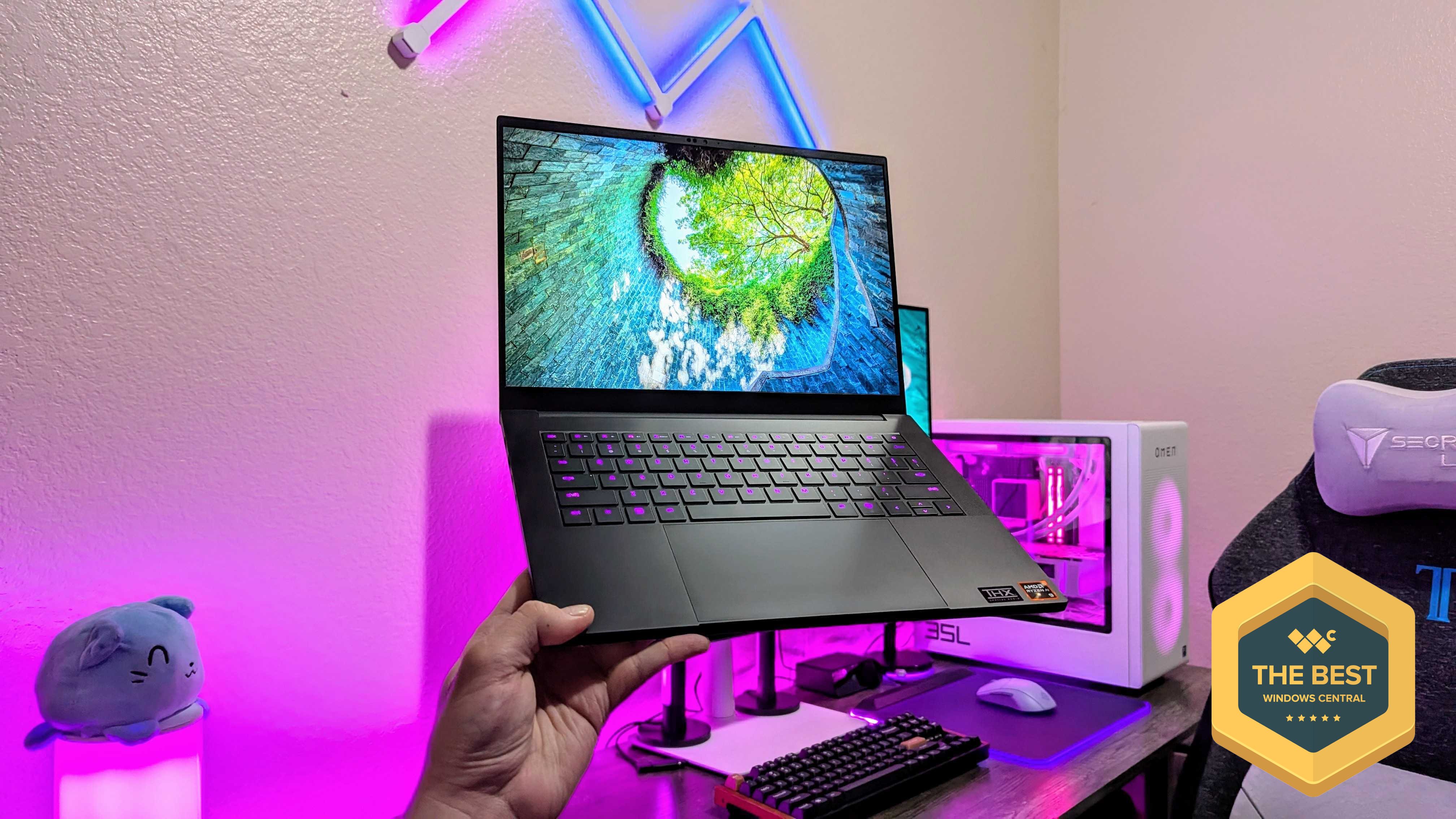
I recently reviewed the Razer Blade 16 (2025) and found it to be a massive improvement over its predecessor, a gaming laptop that felt mismatched with its engorged price tag.
It's Razer's smallest gaming laptop that is its best seller, though, and the Blade 14 received the same treatment for 2025 as the Blade 16 — a thinner and lighter redesigned chassis, and all-new AMD and NVIDIA hardware for better gaming performance and more AI features.
The result? One of the greatest compact gaming laptops you can buy. The Blade 14 is a seriously impressive display of engineering with far more strengths than weaknesses, but the real question most should be asking is: who should actually buy the Razer Blade 14 (2025)?
This review was made possible thanks to a review sample provided by Razer. Razer had no input nor saw the contents of this review prior to publication.
Blade 14 review: Pricing and specifications
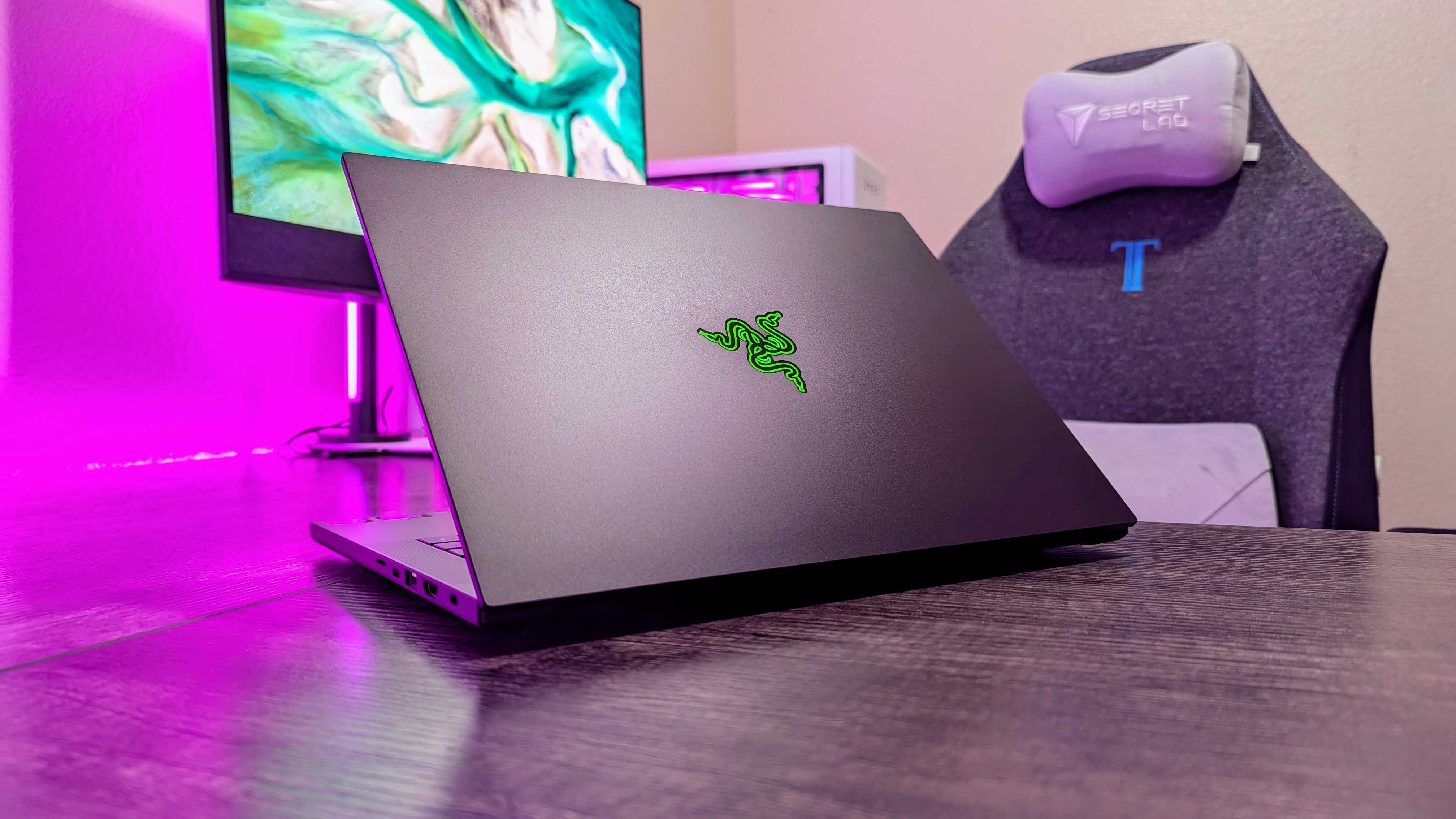
Like always, the Razer Blade 14 (2025) is a ridiculously pricey laptop, but you are getting the pinnacle of premium design, as well as most of the features you could ask for in a laptop.
The Razer Blade 14 (2025) starts from $2,299.99 at Razer, which is equipped with an AMD Ryzen AI 9 365 chipset, NVIDIA GeForce RTX 5060 GPU, 16GB of RAM, and 1TB of SSD storage.
My review configuration upgrades to an RTX 5070 GPU and 32GB of RAM for $2,699.99 at Razer. If you want the best of everything, you can upgrade to 64GB of RAM and 2TB of SSD storage for $2,999.99 at Razer.
There's also a "Mercury White" (it's silver) colorway.
Spec |
Razer Blade 14 (2025) |
|---|---|
Display |
14-inch OLED, 16:10 aspect ratio, 2.8K (2,880 x 1,800) resolution, 120Hz refresh rate, 0.2ms response time, 400 nits max brightness, 100% DCI-P3 color gamut, NVIDIA G-SYNC & Advanced Optimus support, Calman Verified |
CPU |
AMD Ryzen AI 9 365 (Zen 5, 10 cores, 20 threads, up to 5GHz max boost) |
GPU |
Up to NVIDIA GeForce RTX 5070 (Blackwell, 8GB GDDR7 VRAM) |
NPU |
AMD XDNA 2 (Up to 50 TOPS) |
Memory |
Up to 64GB LPDDR5X @ 8,000MHz |
Storage |
Up to 2TB M.2 2280 NVMe PCIe Gen 4x4 SSD (expandable up to 4TB) |
Ports |
2x USB Type-C 4.0 ports (40GBps, DisplayPort 1.4 via Radeon 880M iGPU, 100W Power Delivery 3.0), 2x USB Type-A 3.2 Gen 2 ports (10GBps), 1x HDMI 2.1 port, 1x microSD card slot (UHS-II), 1x 3.5mm audio jack, 1x Kensington Nano Security Slot |
Connectivity |
Wi-Fi 7 2x2, Bluetooth 5.4 |
Battery |
72Whr, 200W charger |
Dimensions |
310.7 x 224.3 x 15.8-16.2mm (12.23 x 8.83 x 0.62-0.64in) |
Weight |
1.63kg (3.59lbs) |
Warranty |
1-year limited laptop warranty, 2-year limited battery warranty, RazerCare support |
In the box, you'll find the Razer Blade 14 (2025) gaming laptop, Razer's proprietary 200W DC charger, and 1 month of Xbox Game Pass Ultimate. Razer also offers its RazerCare extended warranty and colorful Razer skins for the Blade 14.
Blade 14 review: Design and build quality
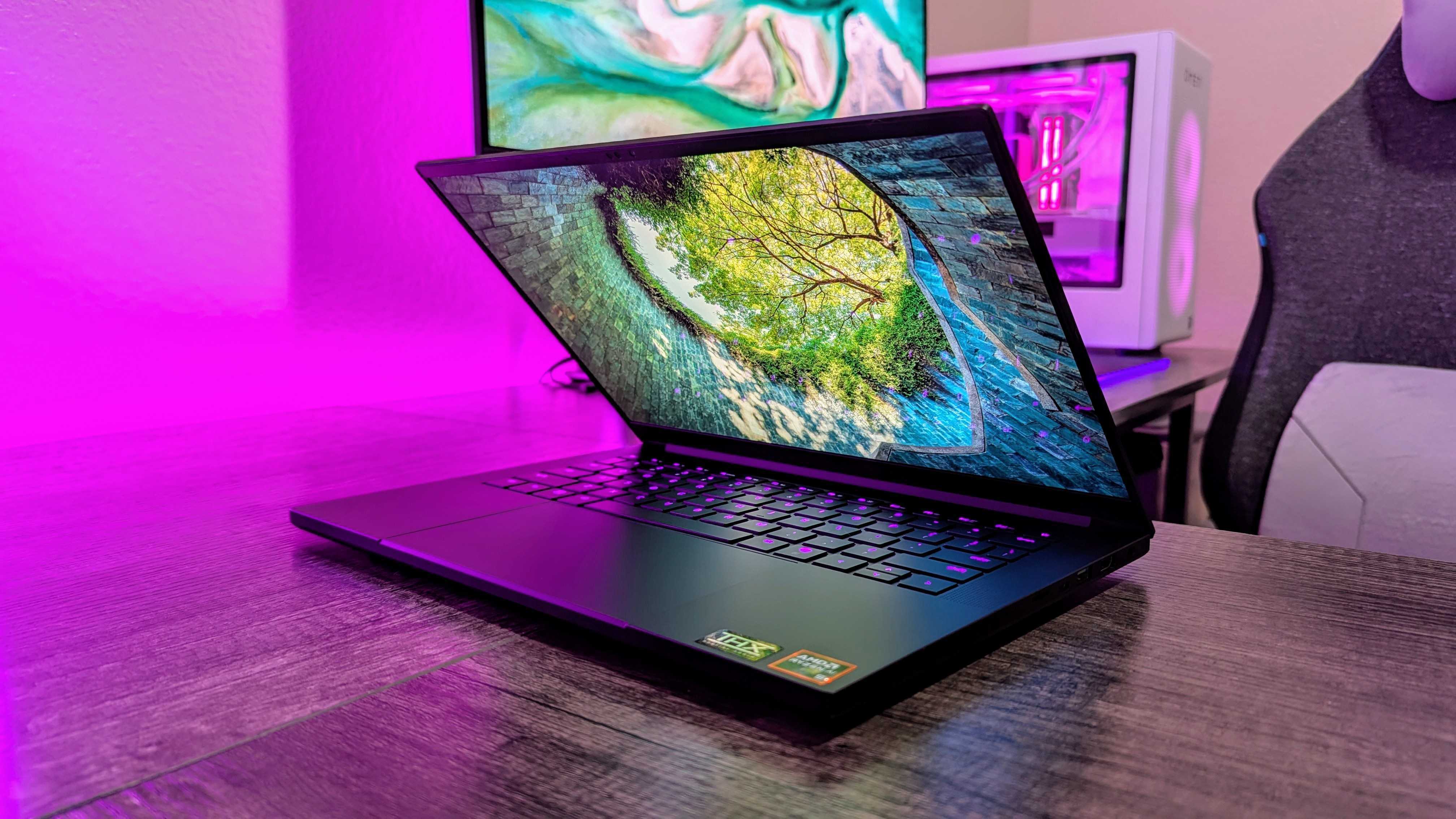
The Razer Blade design language is iconic at this point, and Razer hasn't dramatically changed its hand with the latest round of redesigns. This is all about refinement, and the finer details do make a sizeable impact.
The new Blade 14 is 11% smaller than the Razer Blade 14 (2024) we reviewed, dropping around 2mm in thickness and a third of a pound in weight. It's still CNC-milled out of a single block of high-grade aluminum, but it's sleeker and more comfortable than before.
Razer didn't make any noticeable changes to its anodization and electrochemical bonding process, though, so the matte black color looks as amazing as always — until you touch it, where it'll greedily hold on to every smudge.
I mentioned in my initial hands-on of the new Razer Blade 14 that it felt like Razer finally closed the gap with the ASUS ROG Zephyrus G14 I reviewed, and my mind hasn't changed. The Blade 14 always had phenomenal build quality, but the new design is a big improvement in aesthetics.
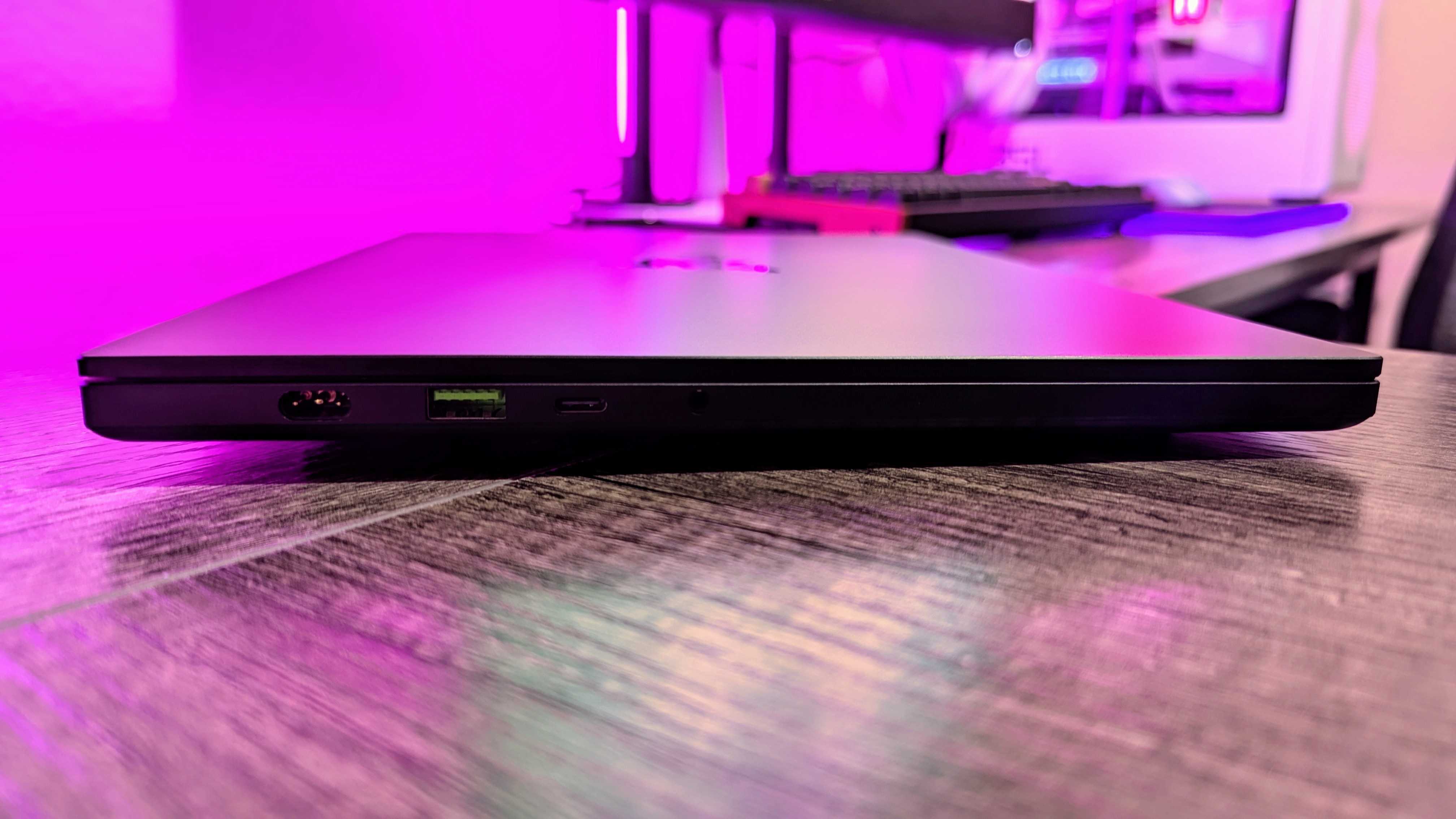
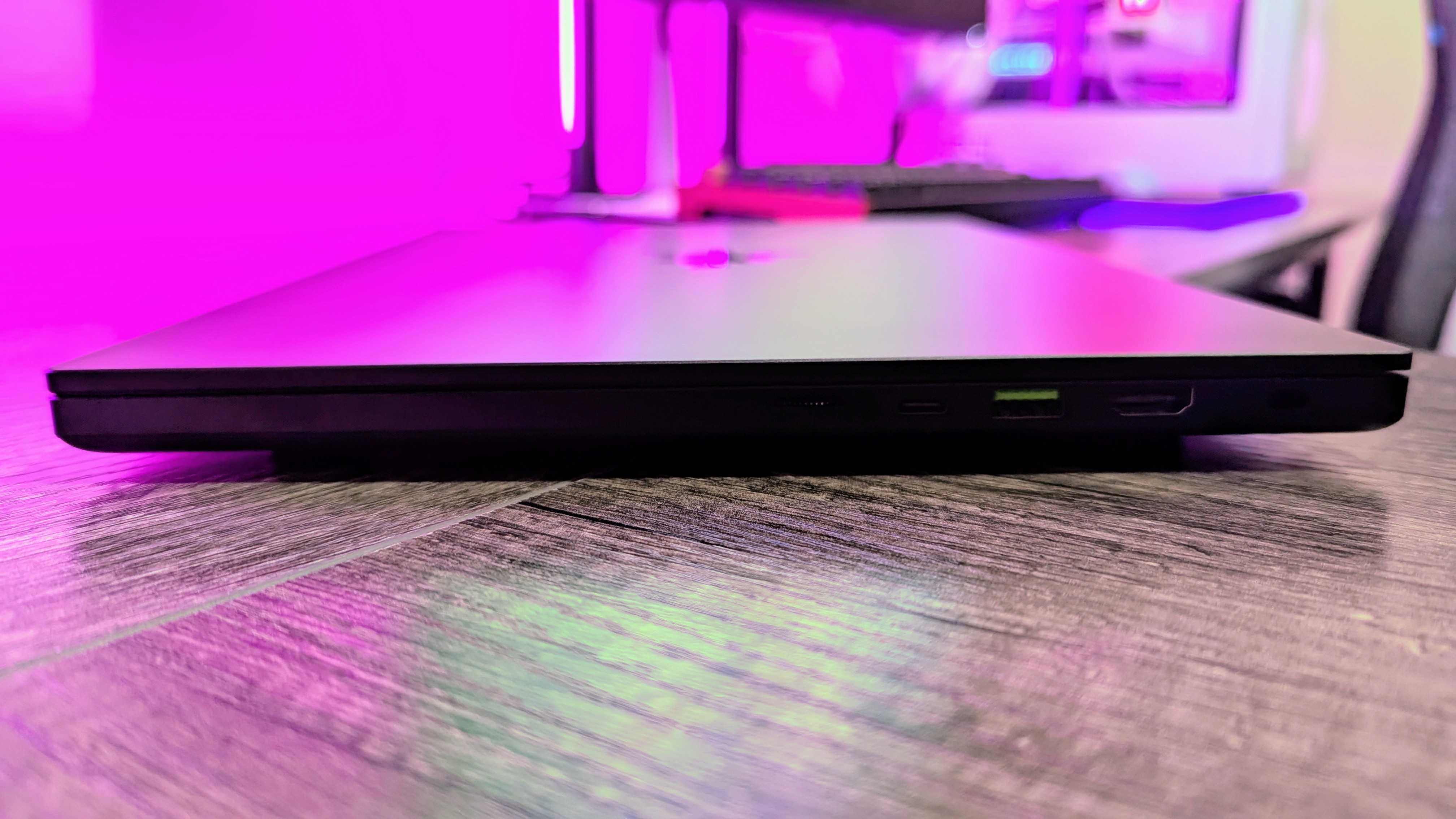
It's impressive enough to make a 14-inch gaming laptop smarter, faster, thinner, and lighter in one go, but where Razer really surprised me is that it didn't cut any features to make those reductions... In fact, it added more.
You're looking at a very familiar array of ports, with connectivity rivaling much larger laptops thanks to dual USB4 ports with Thunderbolt 4 capabilities (including 100W Power Delivery for when you're on the move and need a quick charge), full bandwidth USB Type-A ports, and HDMI 2.1 display output.
However, Razer actually added a new microSD card slot as well, which will make some people very happy. I'll talk more about them later, but there's also an additional two speakers under the hood, so the Blade 14 rocks the same six-speaker system as both its larger siblings.
Blade 14 review: Display quality

On the display front, last year's Blade 14 rocked an IPS LCD panel with a 240Hz refresh rate. This year, Razer decided to follow in the wake of many other premium, 14-inch laptops with a higher resolution, lower refresh rate OLED display.
You're looking at a 2.8K resolution (1800p instead of 1600p from last year), a 120Hz refresh rate, a blisteringly fast 0.2ms response time, and all the vibrant colors and punchy contrast expected from OLED.
It's a familiar screen, and that comes with the same strengths and weaknesses. On one hand, this display looks gorgeous and offers best-in-class performance for gaming. While the refresh rate has technically been downgraded, 120Hz is perfect for the Blade 14's capabilities, and everything looks crisp and defined.
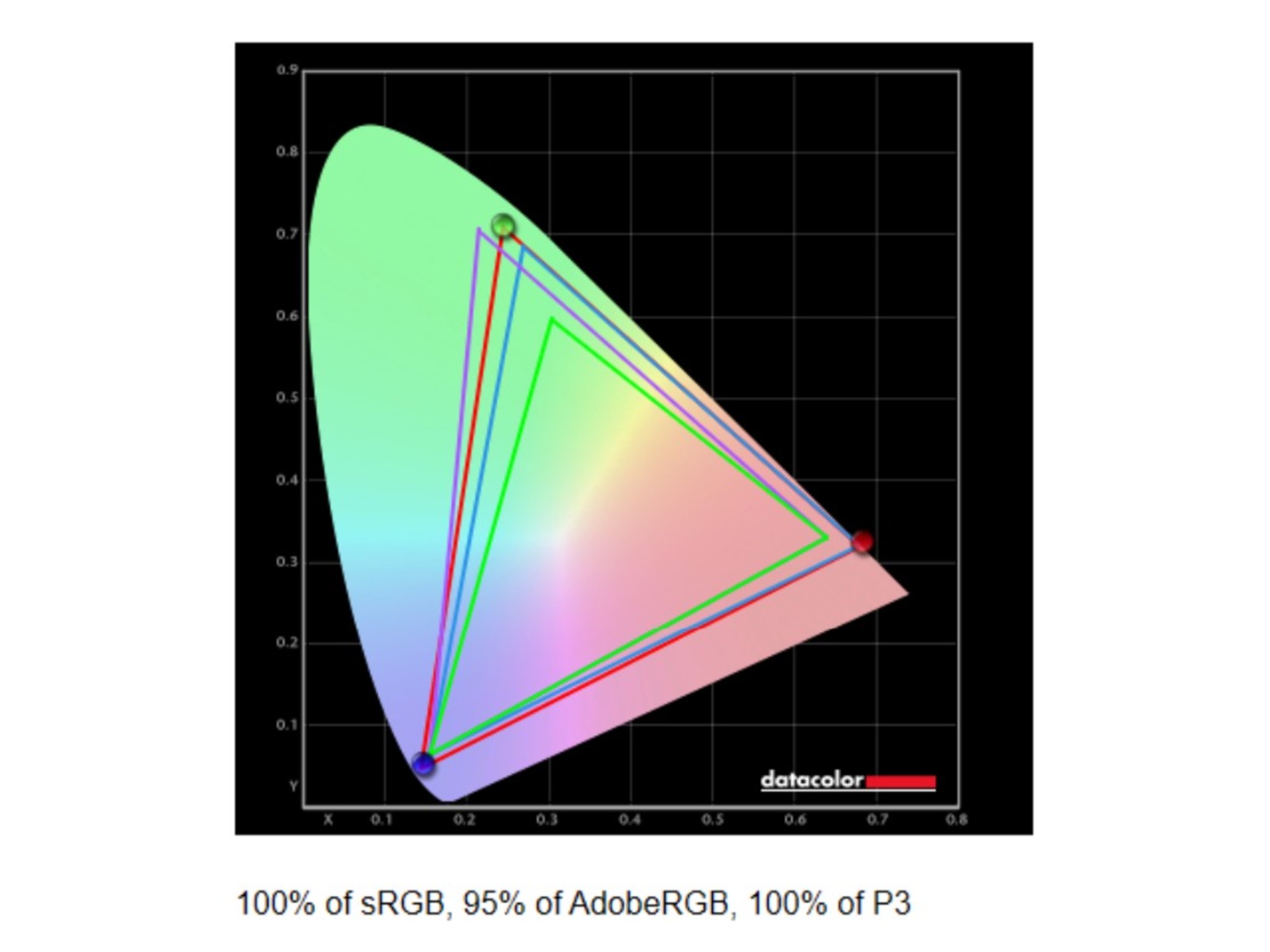
Setting |
Brightness (nits) |
Black |
Contrast |
White point |
|---|---|---|---|---|
0% |
4.4 |
0 |
Infinite |
6,800K (0.308, 0.326) |
25% |
30.3 |
0 |
Infinite |
6,600K (0.312, 0.330) |
50% |
91 |
0 |
Infinite |
6,500K (0.313, 0.330) |
75% |
210.4 |
0 |
Infinite |
6,500K (0.313, 0.331) |
100% |
398.7 |
0 |
Infinite |
6,500K (0.312, 0.331) |
The new OLED display is also more color accurate than last year's panel, which will make a difference for creators. White balance is very consistent across higher brightnesses, too, so photo and video editors shouldn't have any complaints.
High Dynamic Range (HDR) support is here, although Razer didn't disclose the exact standards to me. Either way, though, this is where the weaknesses come in. This OLED display boasts only average brightness, and it's noticeably lower than last year's IPS LCD screen.
On top of the lowered brightness, you do also need to contend with Pulse-Width Modulation (PWM) for dimming. Most people won't be affected, but there are sensitive users who may experience headaches or eye fatigue from the rapid flickering at lower brightnesses, and Razer sadly doesn't offer an alternative display option for the Blade 14.
Blade 14 review: Performance and thermals
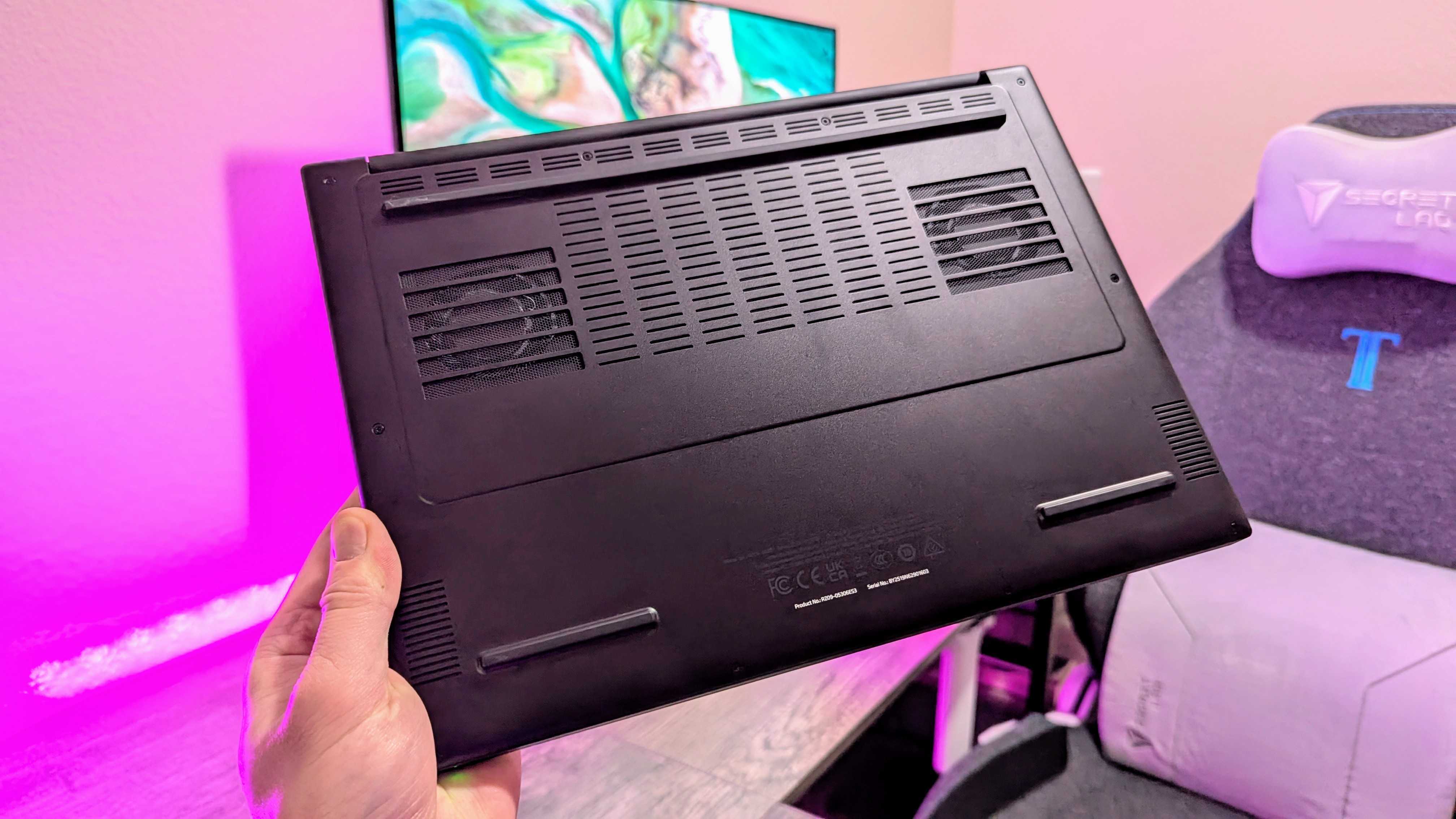
It's a given that you'll have to sacrifice some performance with a 14-inch gaming laptop, because that's how physics works. Still, the latest Blade 14 is consistently more performant than its predecessor while being both thinner and lighter, and there are some reasons for that.
Largely, it's due to the completely redesigned thermal hood, which moves the hottest components under the same comprehensive vapor cooling chamber and refined dual-fan system. On the other side, the new AMD Ryzen AI and NVIDIA GeForce RTX 50-series hardware are more efficient than the last generation.
AMD, especially, makes a big difference here. I have a lot of respect for the latest Ryzen AI chipsets, which can't quite compete with Intel and Qualcomm's most efficient mobile hardware, but easily bests both in terms of gaming, creative, and AI performance.
The result is an excellent computing experience. The Blade 14 feels every bit as responsive as it should, considering how much it costs, and is completely quiet the majority of the time.
My only complaint is that AMD still isn't as good as Intel or Qualcomm when it comes to quickly waking from sleep or standby.
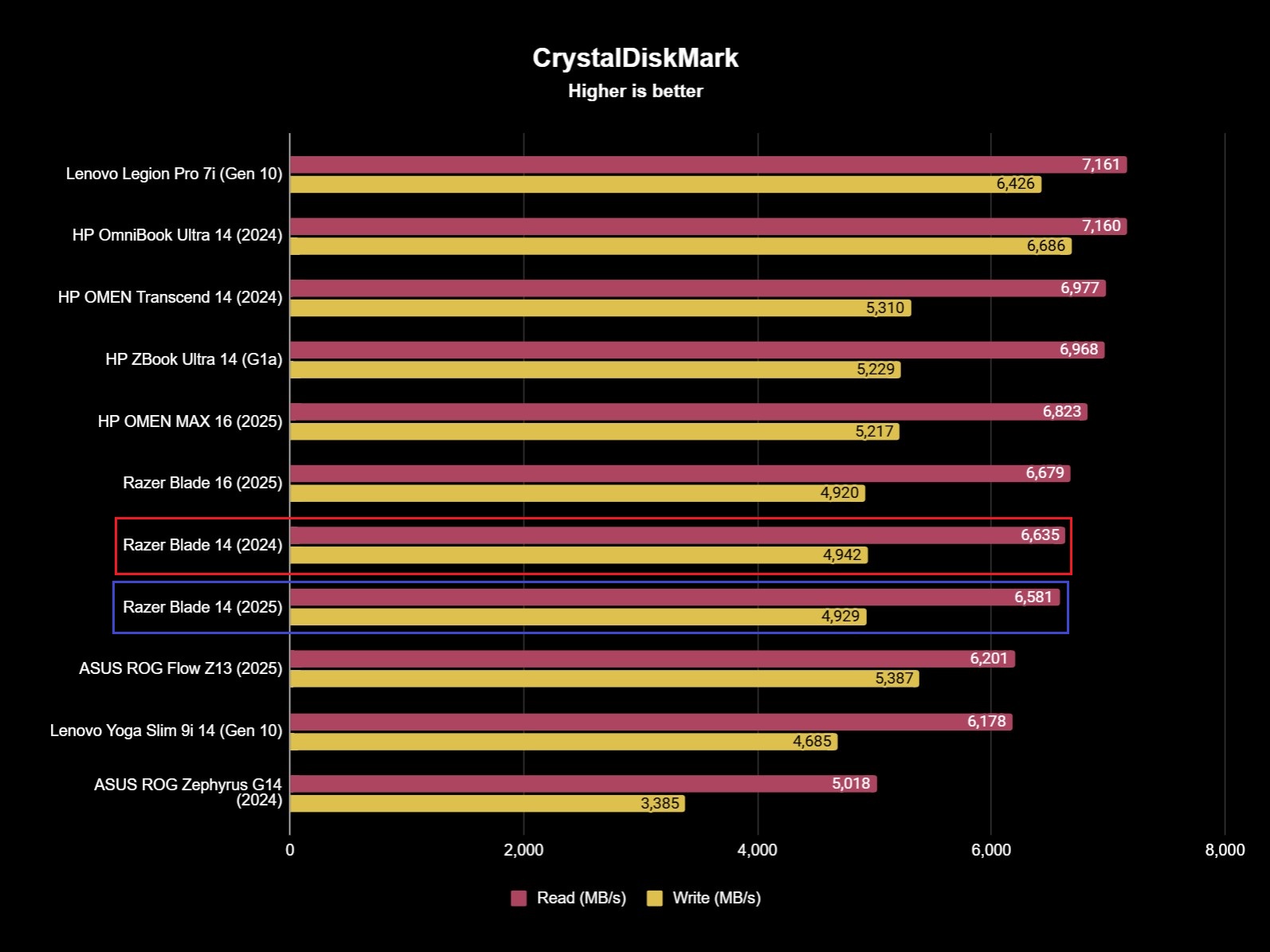
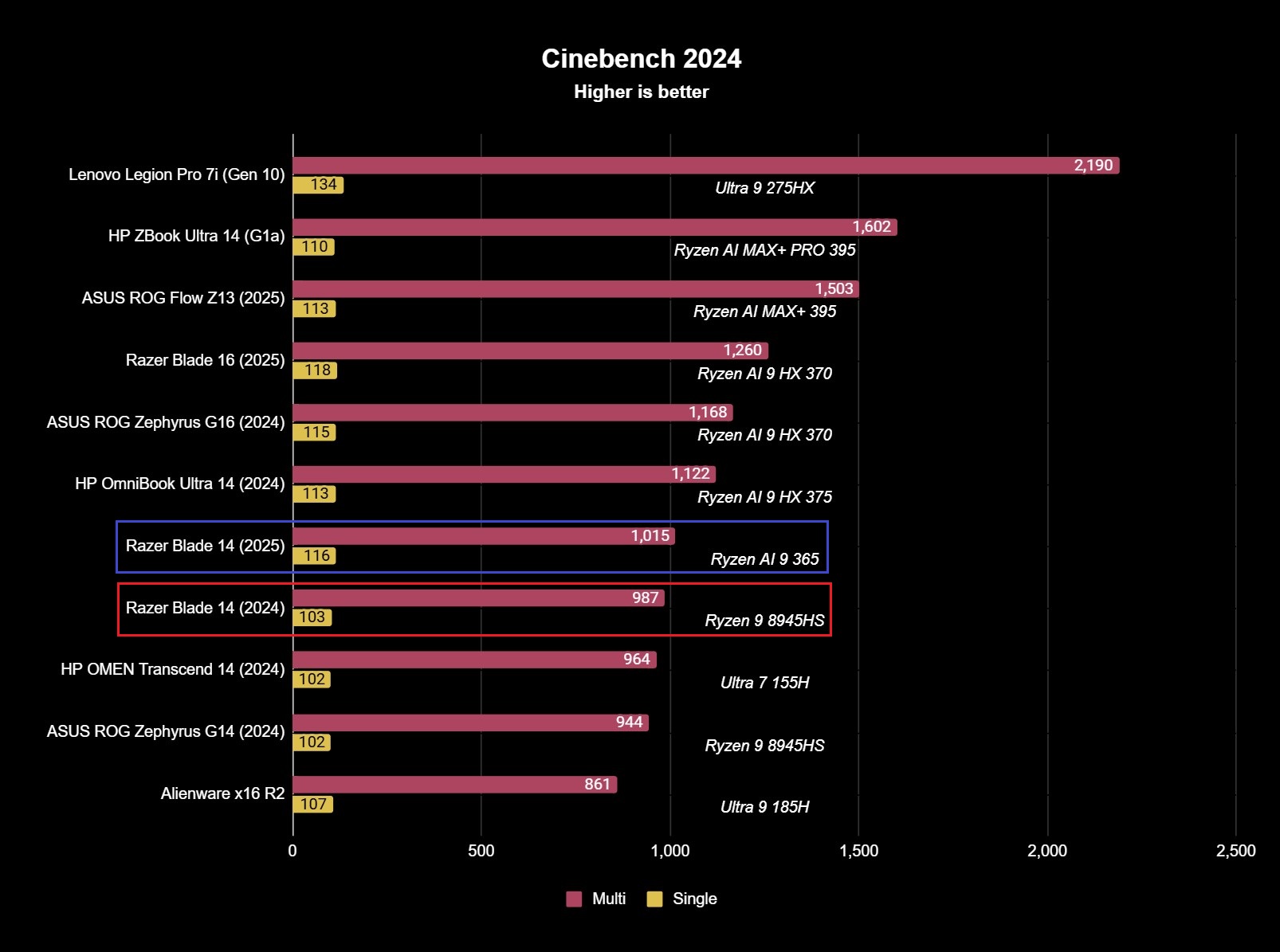
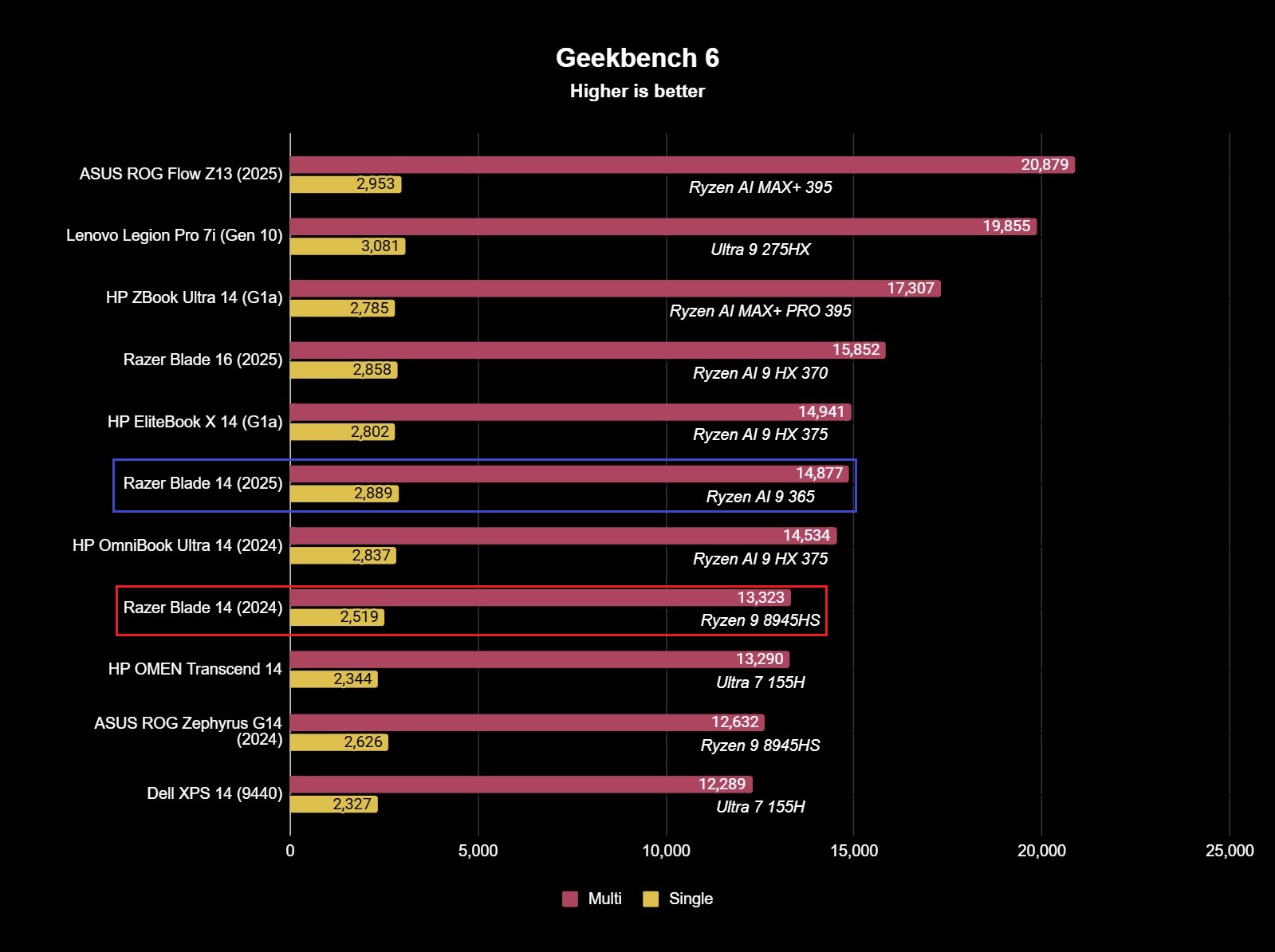
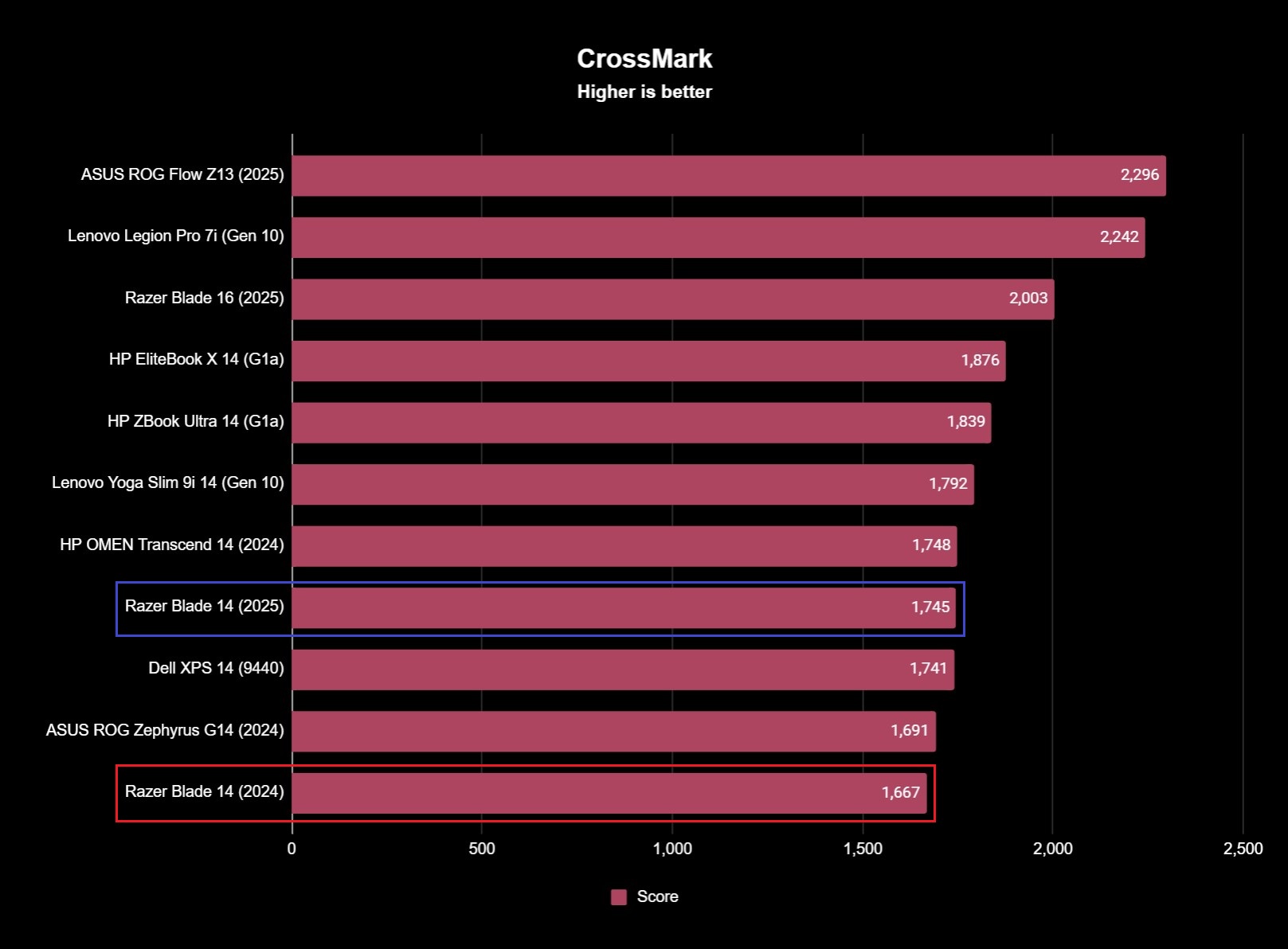
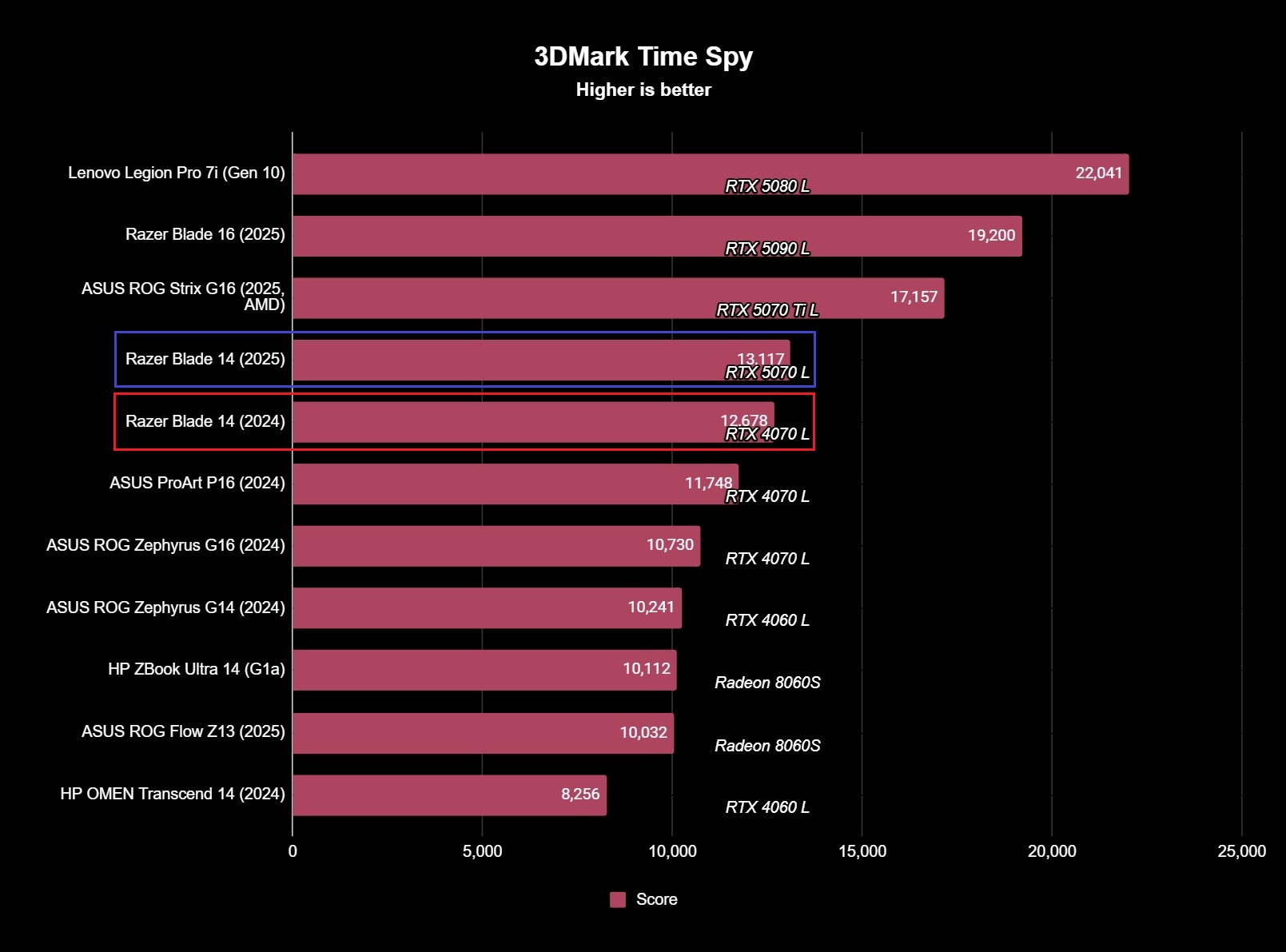
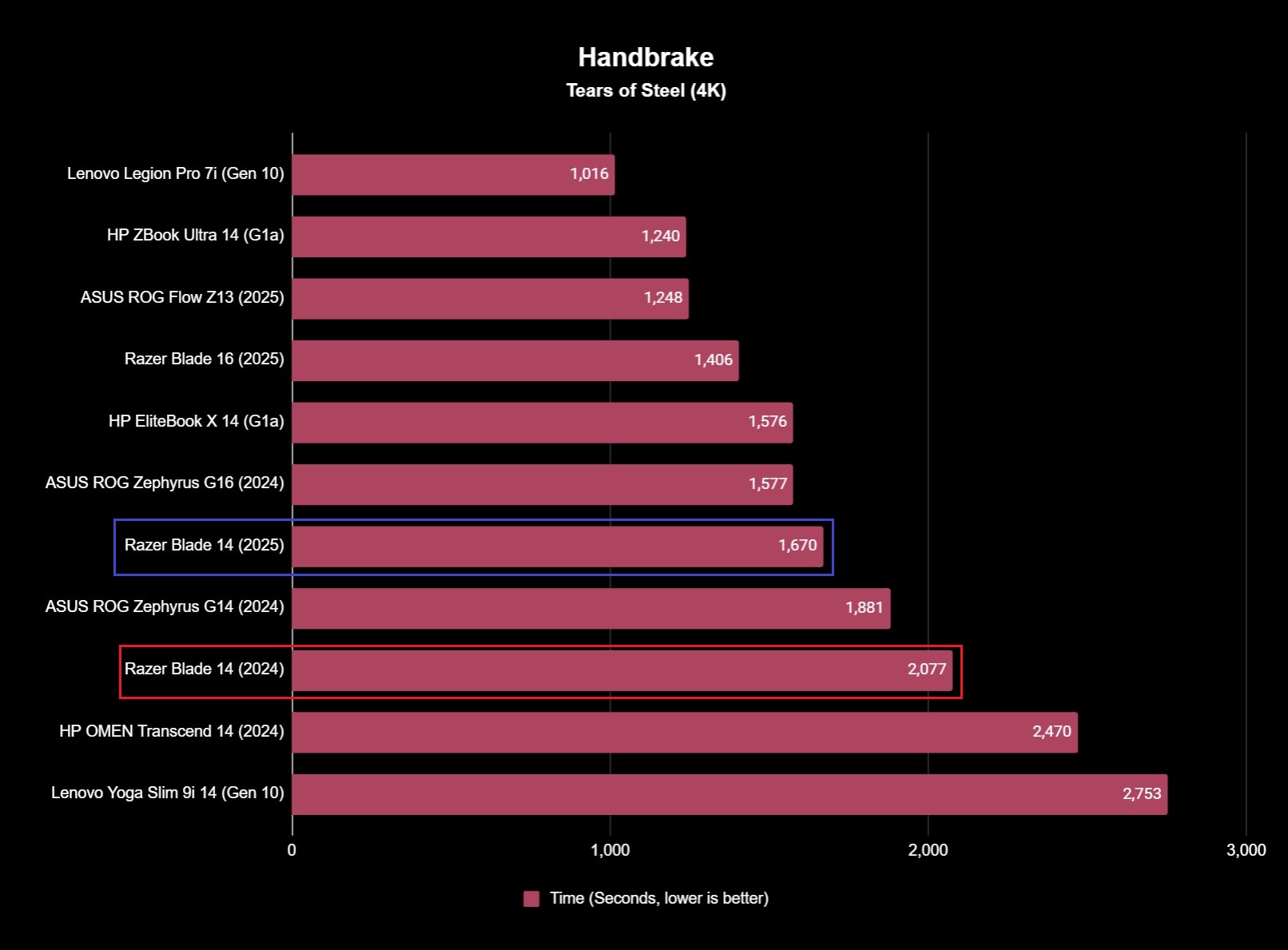
There were no surprises when benchmarking the Blade 14. Its AMD Ryzen AI 9 365 is a highly capable 10-core chipset, but it's also far from the most powerful in the Ryzen AI lineup.
The same goes for the NVIDIA GeForce RTX 5070, which is a balanced mid-range GPU with 8GB of VRAM, so it's more than enough for all the best PC games right now. In the Blade 14, that 5070 is running at 115W TGP, which is less than Razer's larger laptops but competitive with other 14-inch gaming machines.
Year-over-year, performance gains are minimal (around 12% for CPU and 3% for GPU), but the Blade 14 (2025) possesses one extremely important advantage: much better thermal performance.
The new Blade 14 runs cool and quiet most of the time, but the fans can get loud as they spin up — at least it's a low whir, rather than a high whine. The Blade 14's keyboard deck can also get hot, but never quite hot enough that I couldn't comfortably touch it.
I ran the Blade 14 through 3DMark's Time Spy benchmark 25 times consecutively, and there was a 99.1% similarity between the best and worst loops. For comparison, the Blade 16 scored 98.1%, which is where a lot of modern gaming laptops land.
- Forza Horizon 5 — 106 FPS (Extreme preset, 1600p resolution, 120Hz refresh rate, v-sync enabled, NVIDIA DLSS Super Resolution/Frame Generation/Reflex Low Latency disabled) | 74 FPS (Max settings, NVIDIA DLSS Super Resolution set to Auto, NVIDIA DLSS Frame Generation/Reflex Low Latency enabled)
- Gears 5 — 81 FPS (Ultra preset, 1600p resolution, uncapped framerate, v-sync enabled)
- Call of Duty: Black Ops 6 — 92 FPS (Extreme preset, 1600p resolution, 120Hz refresh rate, v-sync enabled, NVIDIA DLSS Super Resolution set to Performance, NVIDIA DLSS Frame Generation disabled, NVIDIA Reflex Low Latency enabled)
- Cyberpunk 2077 — 51 FPS (Ray Tracing: Ultra preset, 1600p resolution, 120Hz refresh rate, v-sync enabled, NVIDIA DLSS Super Resolution Transformer Model set to Auto, NVIDIA DLSS Frame Generation disabled, NVIDIA Reflex Low Latency enabled) | 51 FPS (Ray Tracing: Overdrive preset, v-sync disabled, NVIDIA DLSS Multi-Frame Generation set to 4x, NVIDIA DLSS Ray Reconstruction enabled)
When gaming, the Razer Blade 14 (2025) is a competent performer for QHD (1600p) gaming at high to ultra settings, and games will still look great on the 14-inch display at a lower 1200p resolution if you'd prefer more frames.
I had zero issues with the Blade 14's performance, but I have two interesting things to note: first, the RTX 5070 may benefit from NVIDIA's DLSS AI upscaling and multi-frame generation, but the improvements aren't nearly as dramatic as the 5070 Ti and up.
Secondly, the Blade 14 sometimes behaves weirdly with NVIDIA Advanced Optimus, where switching to the discrete GPU causes the display to freeze on its static RGB pixel array until you close the laptop and open it again. It only happened twice, but I've never experienced that with any other laptop.
Blade 14 review: Software and AI experience
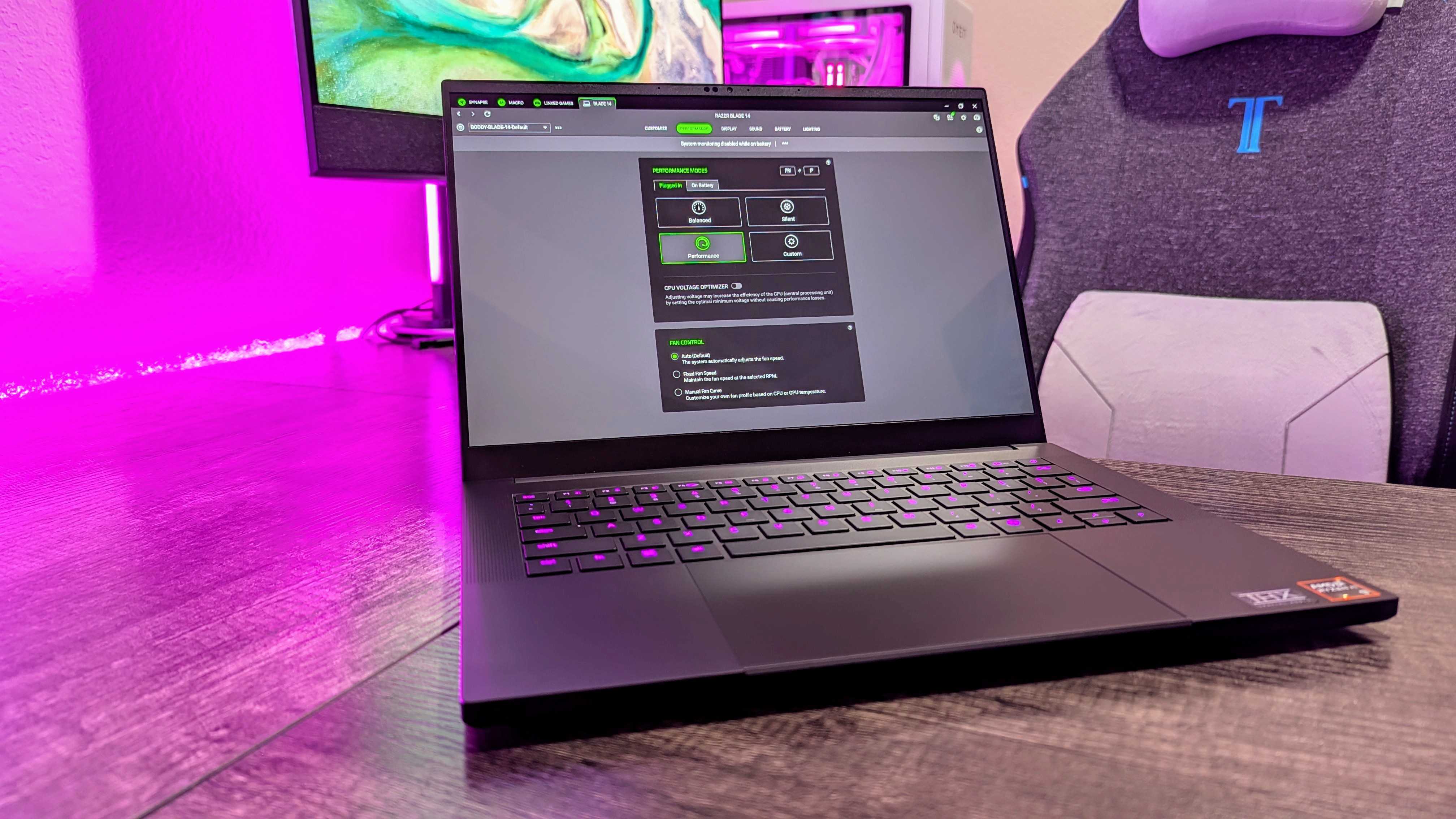
The Razer Blade 14 follows the Blade 16 as one of Razer's first true AI PCs, thanks to the AMD Ryzen AI silicon inside. This is a full Copilot+ PC, so it's future-proofed to get all the best Windows 11 features as they're released.
Razer isn't really taking advantage on its own, with no real AI features to speak of, but between the 50 TOPS Neural Processing Unit (NPU) and the NVIDIA GPU, the Blade 14 should be able to handle any AI task you throw at it across productivity, creativity, and gaming workloads.
Beyond that, this is a clean build of Windows. You'll find the typical NVIDIA and AMD apps, but basically nothing else beyond Razer's Synapse and Chroma applications for managing your laptop, Razer accessories, and RGB lighting.
Razer Synapse 4 doesn't go crazy with the amount of control it gives you over your Blade 14, but all the basics you need are there, plus a few more.
Blade 14 review: Battery experience
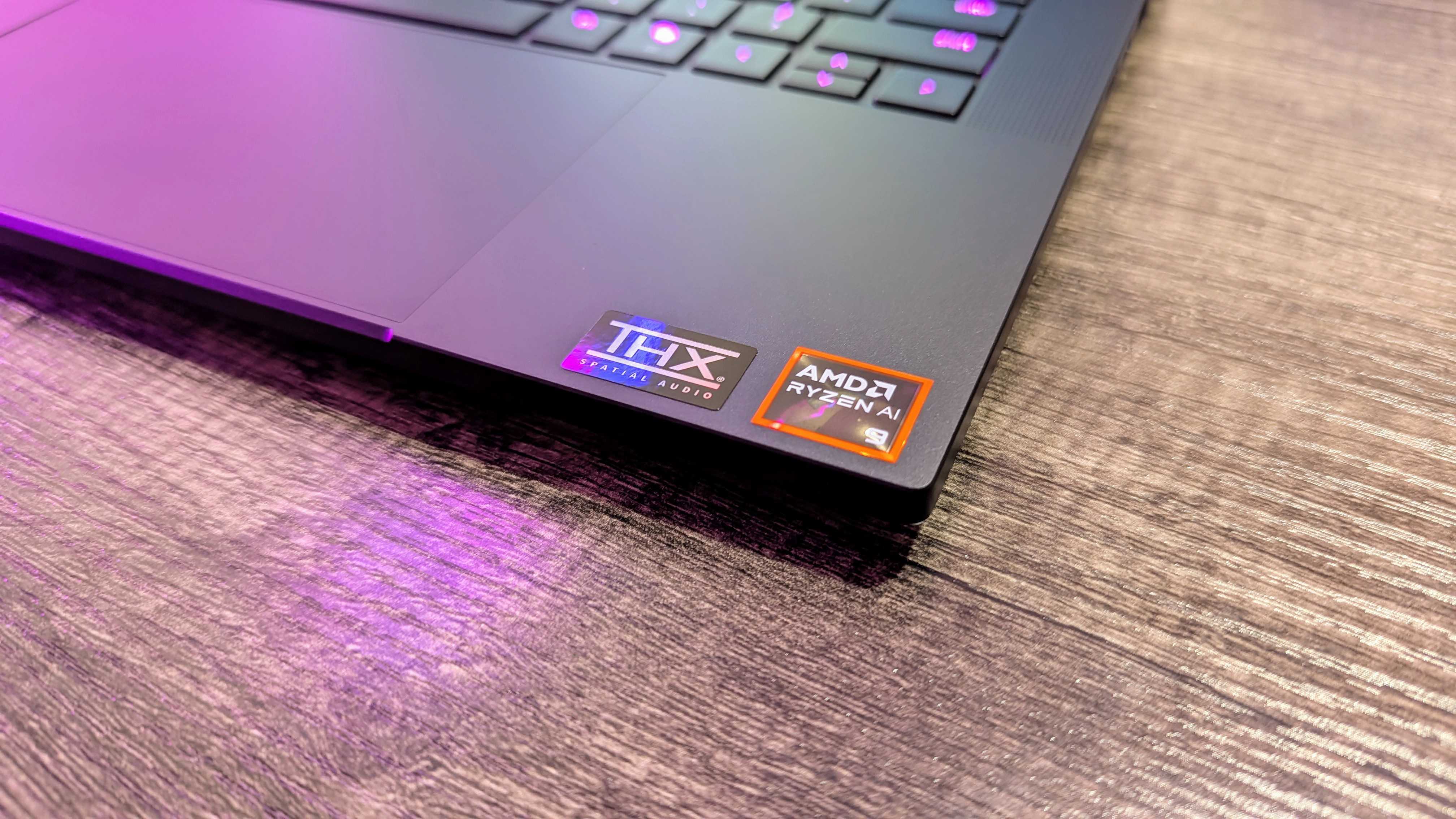
You shouldn't be buying a gaming laptop if you need amazing endurance, but the Blade 14 attempts to strike that balance better than most, with some degree of success.
Running the Blade 14 through an hour-long loop of generic Microsoft Office tasks resulted in a battery drain of 22%, while looping an HD video at 50% volume took off 21% of the battery.
That's already a bit better than most 16-inch laptops, and running a Windows Battery Report showed I was able to get around 6 hours of actual usage out of the Blade 14 without throttling every feature into the ground, which isn't bad.
With some compromise, like disabling the keyboard lighting, reducing performance, and lowering screen brightness, you can get the Blade 14 through a full work day (as long as you're not constantly spinning up that GPU).
On battery power, expect to lose around 30% and 37% of your CPU and GPU performance, respectively — that's a sizeable bump down, but it's again better than a lot of larger gaming laptops.
Blade 14 review: Keyboard and touchpad

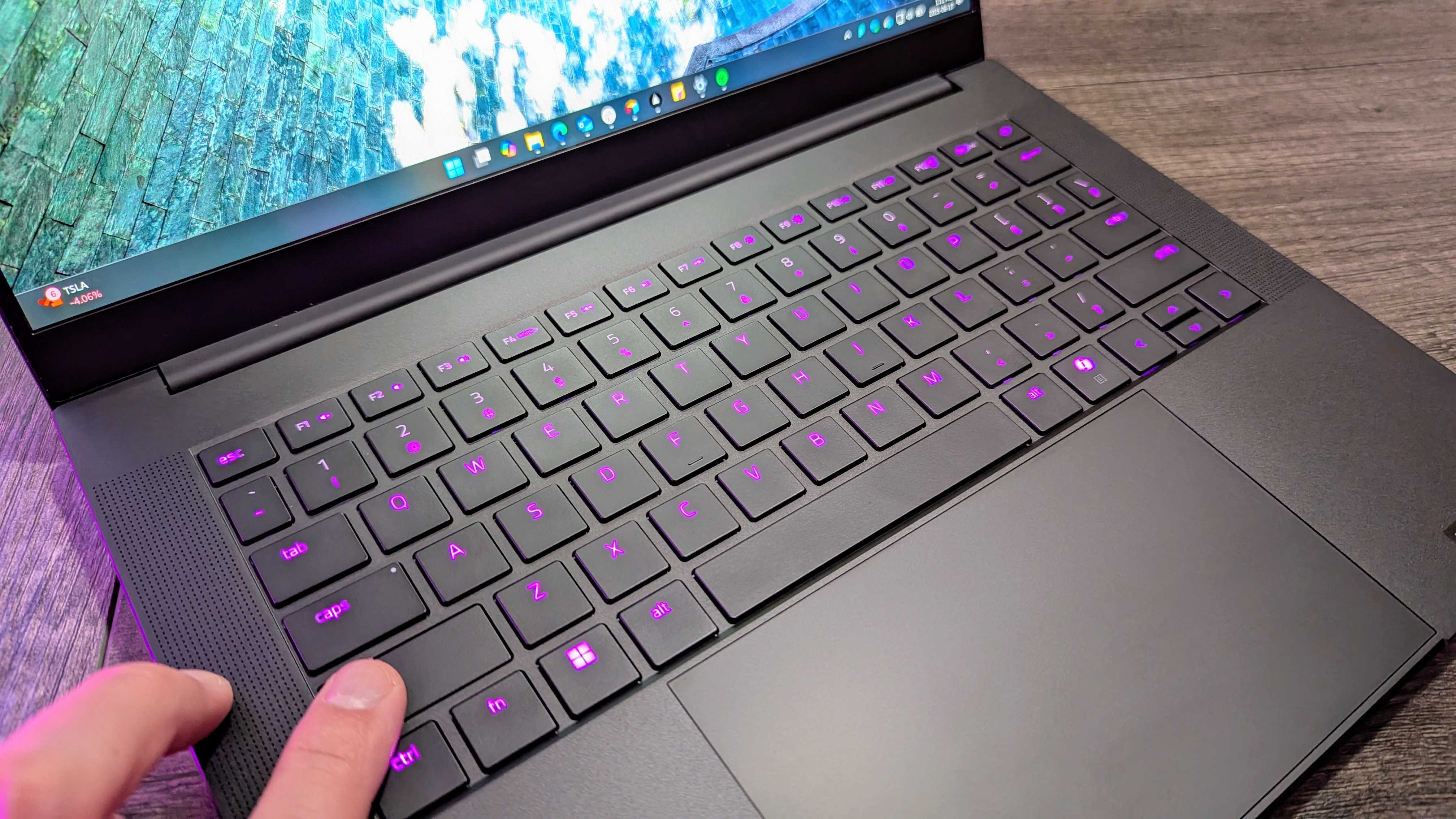
The keyboard is one area where the Blade 14 didn't receive the same treatment as its big sibling, as it's still the shallow 1mm keyboard as before. Off the bat, this isn't my favorite keyboard in a 14-inch laptop by any means, but I enjoyed typing and gaming on the Blade 14 more than I expected.
Key action is tactile and responsive, and I do like this layout. Razer also implemented its two-stage RGB lighting for keys with secondary functions, helpfully highlighting them when you press the Fn or Shift keys. It's an amazing detail that all premium laptops should adopt.
As an aside, Razer still has some of the best RGB lighting in the business, so the per-key lighting on the Blade 14 looks fantastic and is easy to customize.
The touchpad is still comically large, which some people will love. It's a mechanical touchpad, rather than a more premium haptic touchpad, but it's at least coated in slick, high-quality glass, employs Microsoft Precision drivers for gesture support, and is responsive and precise to use.
Blade 14 review: Other hardware
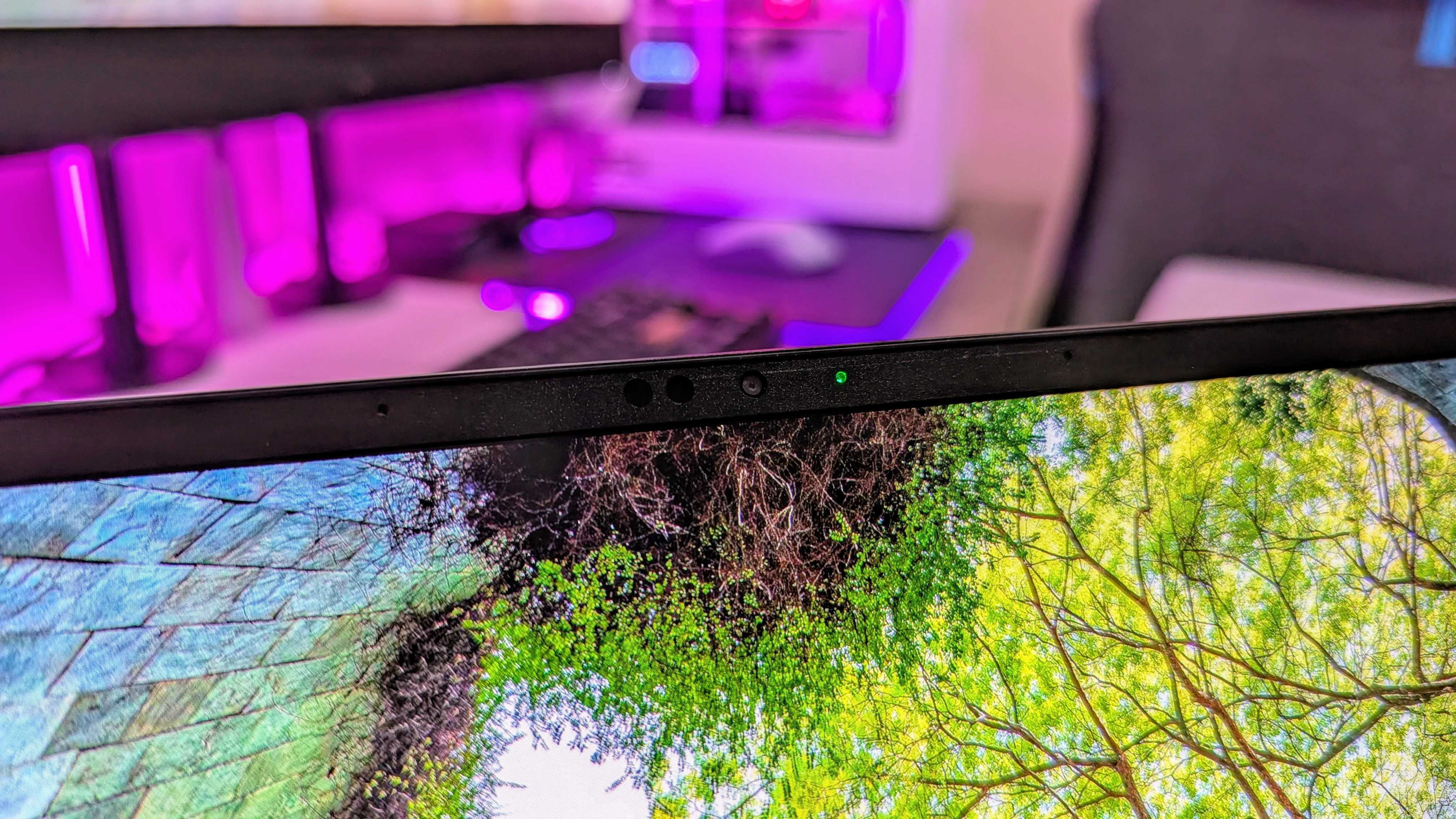
The Razer Blade 14 is undoubtedly a premium laptop, so it boasts a lot of luxuries you're not guaranteed elsewhere... But Razer didn't stuff everything and the kitchen sink in here.
The front-facing, FHD webcam and microphone array are decent and more than usable, but nothing exceptional. You at least get an IR sensor for Windows Hello facial recognition, but that feature no longer works in the dark (and you don't get a fingerprint sensor for backup authentication).
There's also no proximity sensor for the Human Presence Detection (HPD) features common with other premium AI laptops, nor an ambient light sensor for automatic brightness or color temperature adjustment. Most people won't miss those features, though.
Wireless connectivity is at least cutting edge with Wi-Fi 7 and Bluetooth 5.4 on board, although I do wish Razer would bake its proprietary HyperSpeed Wireless technology into its laptops for easy accessory pairing.
One area where the Blade 14 is hands-down at the cutting edge is with audio, as it boasts a mighty impressive six speakers packed into its petite frame, tuned with THX 7.1 surround sound in mind. Physics still plays a part with such a small laptop, but these speakers are really good.
Blade 14 review: Also consider
Blade 14 review: My final thoughts

✅You should buy this if ...
- You want a premium 14-inch laptop with power for high-end gaming.
- You want your laptop to make a statement with its design.
- You want a gaming laptop designed with AI features in mind.
❌You should not buy this if ...
- You only plan to occasionally use the discrete graphics.
- Reliable, all-day battery life is an absolute must.
Razer laptops have never been known to be affordable, and the Blade 14 is no exception. This is a costly machine, and a lot of that is tied up in the intricate way Razer constructs it.
The redesigned Razer Blade 14 (2025) is easily my favorite Razer laptop so far, though, and proves to me why the smallest in the lineup is also the best-selling. This is an excellent gaming companion with enough power for all the latest and greatest games, but a design thin and light enough to carry around with you everywhere.
It's also more capable of surviving a full day of work than most gaming laptops, making it a potent option for those who want a premium device for work, play, creativity, and — increasingly important — artificial intelligence.
The Blade 14 is still overkill for a lot of people, though, and those only planning to casually game or occasionally use those beefy NVIDIA graphics may be better off with one of the shockingly capable Intel or AMD ultrabooks from companies like Lenovo or HP.
Those of you who know what they need, though, can get the Razer Blade 14 (2025) from $2,299.99 at Razer right now. If you want my recommendation, get it in silver.
The Razer Blade 14 has never been so good, and it's now one of my favorite gaming laptops I've reviewed in a long while. It's a balanced gaming and productivity companion with all the power you need in a compact chassis, and just enough battery to stave off those anxieties away from an outlet.







